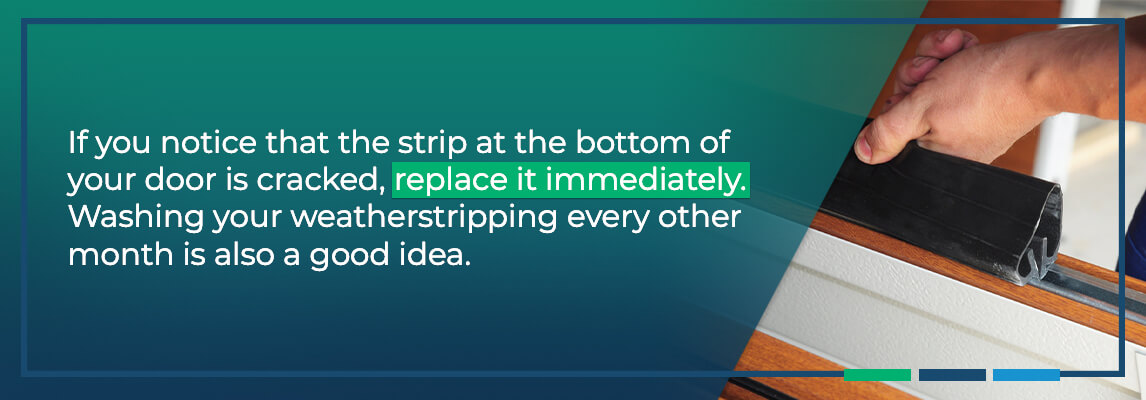
Garage doors are the largest moving objects in our homes and are raised and lowered over a thousand times per year. Needless to say, these motorized doors experience considerable wear and tear and, with all the moving parts they contain, can malfunction in a variety of ways.
If you want to avoid costly repairs and the inconvenience of a malfunctioning or broken garage door, make sure to perform regular maintenance. If you’re unfamiliar with garage door maintenance or just don’t know where to start, you need not worry — because we have a useful guide of garage door maintenance tips for you.
Table of Contents
- Garage Door Opener
- Garage Door
- Recommended Installations
- Leave the Maintenance and Repairs to Banko Overhead Door
Garage Door Opener
One of the most important skills is knowing how to maintain a garage door opener, as it may affect the safety of you and your loved ones. Your garage door opener likely includes a variety of safety features, including two safety mechanisms that you should regularly test. These features were designed to prevent the door from closing on a person or a vehicle:
1. Mechanical
To test this feature, place an object such as a brick or piece of wood on the floor so that the garage door will hit it when it comes down. When you lower the door and the door hits the object, the door should reverse and go the other direction. You can also test this feature by holding the bottom of the door while it’s closing.
If your door doesn’t stop and reverse quickly after making contact with the object, this means you’ll need to change the force setting. As each system varies, it’s best to consult your manual on how exactly to do this for your particular model.
After making changes to your force setting, make sure to retest your door afterward.
2. Photocell
Modern garage door systems typically have infrared sensors to detect whether the doorway is clear or not. If you have an opener that’s over 20 years old, it likely doesn’t have this feature — which means it’s probably time for an upgrade.
These photoelectric sensors — also called photocells or photo eyes — use an infrared light transmitter and a photoelectric receiver. If an object is detected in the path of the door, the door will not close. If your garage door system includes this photocell feature, make sure that the height of your sensors does not exceed 6 inches.

To test this safety feature, first open your door and stand close to the sensor while holding a large object, and close the door using the remote. While the door is closing, move the object around in front of the sensor. If your photocell is working properly, the door should quickly reverse direction.
If your door doesn’t reverse, check to make sure the photo eyes are properly aligned. For your garage door to function, the photocells must be facing each other. If the sensors need to be aligned, you will probably see blinking lights. If you gently move the sensors so that they align perfectly, the light that is blinking should turn solid again.
If you’ve realigned them and the light is still blinking, consult your manual or call a technician.
Battery
If your opener includes a battery backup, this should be tested as well. To do this, disconnect power to your opener to see if the backup battery engages. Try this using either the wall button or the remote. If your door doesn’t open, remove the opener’s cover and replace the battery.
Hinges and Rollers

Hinges and rollers need to be regularly lubricated, and lithium grease is generally the most effesafective lubricant unless the door’s manufacturer suggests otherwise. The following three moving pieces need lubrication:
- Combination hinge and rollers: Lubricate the roller and the hinge that the roller is connected to. These hinges are located on both sides of the door between panels. Try not to use too much grease as it attracts dirt and can interfere with the proper functioning of the door.
- Lock mechanisms on the door: Lubricate the inside of the keyhole and move the key around inside to distribute the grease evenly.
- Hinges in the field or center of the door panels: The hinges holding the centers of the door panels together don’t have rollers, but they still need lubrication. After you lubricate them, open and close the door a few times to distribute the grease evenly.
You also need to inspect your rollers closely and look for any cracks, chips or other blemishes. If your rollers are cracked or chipped, replace them as soon as you can. Whether your rollers are steel or nylon, it is recommended that you inspect them every six months and replace them every six or seven years.
If certain rollers appear to be stuck, soaking them in kerosene may be an effective solution. This is best achieved by taking a small brush and getting kerosene into the cracks. If there is rust, you can scrape it off with steel wool. Once everything is clean, you can add the lubricant.
Cables
Look along your cables for worn strands and any wear and tear near the roller bracket’s bottom. If you notice any wear or damage, you should call a professional to help replace the cable.
Do not attempt to adjust the high-tension cables that lift your garage door. These cables are under enough force to seriously injure you. You can inspect their condition, but get a technician to do the repairs.

Springs
Maintaining your garage door’s springs involves two activities — lubrication and adjustment.
1. Lubrication
If the garage is squeaking frequently or opening and closing less quickly, try coating the springs with a lightweight oil. This is done an average of once per year, but do it whenever you think it is needed.
2. Adjustment
Garage doors have two sets of springs — torsion and extension. Torsion springs are parallel to the top edge of the door and wind up. Extension springs are perpendicular to the top edge of the door and run along the top tracks.
It is recommended that you hire a professional technician to fix torsion springs because they are heavy, dangerous and often require specific equipment to fix. Extension springs, on the other hand, can be adjusted by highly experienced DIYers — but it is best to call a professional technician.
To test the extension springs, first disengage the electric motor and open the door halfway with your hands and leave it that way. If the door starts to move on its own, this means that your door is off-balance and the extension springs need to be adjusted. If your door starts to drop, this means the springs are too loose, and if it starts to go up, the springs are too tight.

To adjust the garage door springs, start with the springs fully slack and the door completely open. For extra safety, prop the door open with a ladder or something else that can serve as a wedge. Adjust the tightness of the spring or cable until the door does not creep up or sink down too quickly.
The balance of your garage door is important, and if it’s off, the opener must work harder to move it up and down and its lifespan will be shorter as a result. It also poses a safety hazard, as a door that’s not properly balanced can fall quickly without warning.
Bolts
Bolts hold your garage door in place. After years of constant use, these bolts can become loose, which interferes with the proper functioning of your door. It’s important to inspect the bolts regularly to make sure they are tight. Take a look at your garage door’s hardware and tighten the bolts with a socket wrench. Replace out bolts that appear worn out or rusty.
Tracks
The tracks contain and guide the rollers of a garage door. Over time, debris and dust and make their way inside the tracks, so the doors will start to roll unevenly. This uneven movement, in turn, causes dents that can make the tracks unbalanced.
To prevent uneven rolling and unbalanced tracks, try to clean the tracks at least once a year. To do this, use a brush with stiff bristles to thoroughly sweep out anything that could interfere with the door rolling properly. After you’ve cleared out the debris, wash the tracks with a wet cloth and household cleaner. Once they’ve been rinsed well, leave them to dry.

The tracks need to be perfectly lined up with the door and level in order to function properly. You can use a laser level to check if the tracks are straight. The tracks should be perfectly level and then tilt toward the back of the garage very slightly. If you need to make an adjustment, you can loosen the brackets that secure them and tap them into the desired place. Once you’ve done this, tighten up the brackets again.
If the tracks need major adjustments, however, hire a professional technician.
Chain
If the chain on your garage door is sagging, you can adjust the tension. You don’t want the chain to hang more than a 1/2 inch under the rail. If it sags too far, it may hit the rail and cause the drive sprocket to wear out more quickly.
To fix this, get a couple of wrenches and tighten the chain nuts, which are found on the turnbuckle. Adjust the chain so it hangs between a 1/4 and a 1/2 inch under the rail’s base. Make sure that the chain is not over-tightened. The methods of tightening vary with the garage door system, so it’s best to consult your manual for instructions or call a professional technician to fix.
Weatherstripping
Weatherstripping refers to the long pieces of material that seal your garage door by filling in the gaps between the door and the ground. This helps to prevent air inside from escaping and helps your home be more energy-efficient.
If you notice that the strip at the bottom is cracked, replace it immediately. Replacing this material is easy — hardware stores sell it by the foot and you can easily cut it to the size you need. When installing, put the wide angle of the flange on the inside.

If your door is wood, you can easily take off the seal with a flat pry bar. Doors made of other materials often require you to remove connectors and fasteners.
To attach your seal, either replace the fasteners or secure the seal with 1-inch galvanized roof nails. For wood doors, you nail one side, stretch the seal across to the other end, and then nail that end down. By nailing down the ends first, cyou can be sure that it will fit properly.
Washing your weatherstripping every other month is also a good idea. Wash it with a vinyl cleaner. Then, to keep it flexible, spray it with a silicone lubricant. Doing this helps the bottom seal from sticking to snow, as well.
Garage Door
Don’t forget about the garage door itself. If you neglect to maintain it, many problems can arise. You can take care of your door in the following ways:
1. Clean It
Garage doors are a dominant feature of your home’s exterior, so it’s worth the effort to keep it clean. Cleaning your door will remove dirt, grime and grease, which can extend its life by protecting it from corrosion.

For pre-finished steel garage doors, make sure to do the following:
- Remove dirt with detergent: Remove dirt using a mild detergent solution such as those used for dish wash or car wash soap. A product that has less than 0.5 percent phosphate is also an option. Mix one of these cleaners with five gallons of warm water.
- Use bleach for tough stains: A solution of diluted bleach and water should help remove stubborn spots. Mixing detergent and bleach can be dangerous, so if you previously used detergent to wash your door, make sure to rinse it off thoroughly before applying any bleach. After you’ve cleaned the stains, rinse the door again.
- Use soft cloths: Clean the door with a soft cloth or sponge that is not abrasive. When drying, use a soft, clean cloth. Rough cloths may damage the acrylic glazing of the door.
For wood doors, clean by doing the following:
- Remove dirt with detergent: When removing dirt, you can use the same materials as you do for pre-finished steel doors.
- Rinse with water: Remove the detergent with water and then let it dry.
- Apply primer in necessary areas. If you notice that the finish is eroding in places, clean these areas where the wood substrate is visible using your diluted detergent solution, then rinse with water and let it dry. Once dry, you can prime these areas with an oil or alkyd primer. Then, prime the entire door and finish coatings.
- If there’s no erosion, just apply and finish. If there are no areas where the wood substrate is visible, you may only have to apply a finish coat.
It’s also a good idea to read through your door’s maintenance brochure for guidance on cleaning your door. If you do not apply the finish properly, you may void your warranty.
2. Maintain the Area Surrounding It
Maintaining the area around your garage door is also important. If water is splashing against the bottom of the door, problems will eventually arise. If your door is made of metal, it will develop rust, and if it’s wood, it will experience rot and peeling paint.

For this reason, make sure that gutters near your garage door keep water away from the door and that the landscape does not cause water to flow in front of the door. You should also remove snow soon after it falls so that it doesn’t melt and refreeze, which could stick the door to the driveway.
3. Paint It
Once you’ve washed your garage door, you may want to give it a makeover with a fresh coat of paint. You can use the same color as before or take the opportunity to create a new, distinctive look for your home’s exterior.
4. Insulate It
While insulation is certainly great for the colder months of the year, it can be beneficial during the summer months as well. By ensuring your door is well insulated, you’ll keep the heat outside and the comfortable, air-conditioned air on the inside. This insulation also makes living spaces directly above your garage more comfortable.
Recommended Installations
In addition to maintaining the parts you have, you may want to consider these simple installations to make things easier:
- Handles: Every year hundreds of fingers get cut or crushed from getting caught in garage doors. A simple way to avoid this potential tragedy is by attaching handles on the inside and outside of the door. This is an easy way to grab the door without endangering your fingers.
- Containment Cables: When extension cables break, they can do considerable damage to things and people nearby. To prevent this, install containment cables for spring doors. They cost just a few dollars, and installing them takes only a few minutes.
Leave the Maintenance and Repairs to Banko Overhead Door
If you’re feeling uncertain about a particular repair or you simply don’t have the time for it, Banko Overhead Doors will do it for you with professionalism and efficiency. If you live in the Tampa Bay area, which includes Hillsborough, Pinellas, Pasco, Hernando, Manatee, Sarasota and Polk Counties, come to us for all your overhead garage door maintenance, repair and installation needs.
At Banko Overhead Doors, we work hard to ensure that our customers’ doors are operating at their peak potential. Our experienced team can quickly identify areas of concern and make efficient repairs to ensure your garage door stays in top shape. We will offer garage door maintenance and tune-ups to both residences and businesses.

We pride ourselves on many aspects of our service, including:
- Same-day repair service: A broken or malfunctioning garage door is both inconvenient and scary. For this reason, Banko responds to each call with the urgency that the situation demands. We have the largest staff of garage door technicians in Central Florida and can dispatch a professional to take care of your problem faster than any other company. Regardless of the brand or model of your garage door, we have the equipment and skills needed to get your garage door back up and running in a single visit.
- Garage door maintenance tune-up: By investing a small amount in maintenance every year, you will likely avoid costly repairs and inconvenience later on. Seeing thousands of garage doors every year, we at Banko have found that preventative maintenance is a great way to get the most out of your investment.
- Full-time technician staff: Our staff consists of experienced technicians who are trained to meet our company’s standards of quality and excellence. We never contract technicians because we are committed to delivering a consistent, exceptional experience with every customer.
Contact Banko Overhead Doors at 877-90-BANKO or via our online contact form to schedule a repair.
Additional Resources on Garage Door Repairs and Maintenance:
- Garage Door Maintenance Checklist
- 4 Summer Garage Door Maintenance Tips
- 5 Reasons Your Garage Door Isn’t Working
- Common Garage Door Issues










